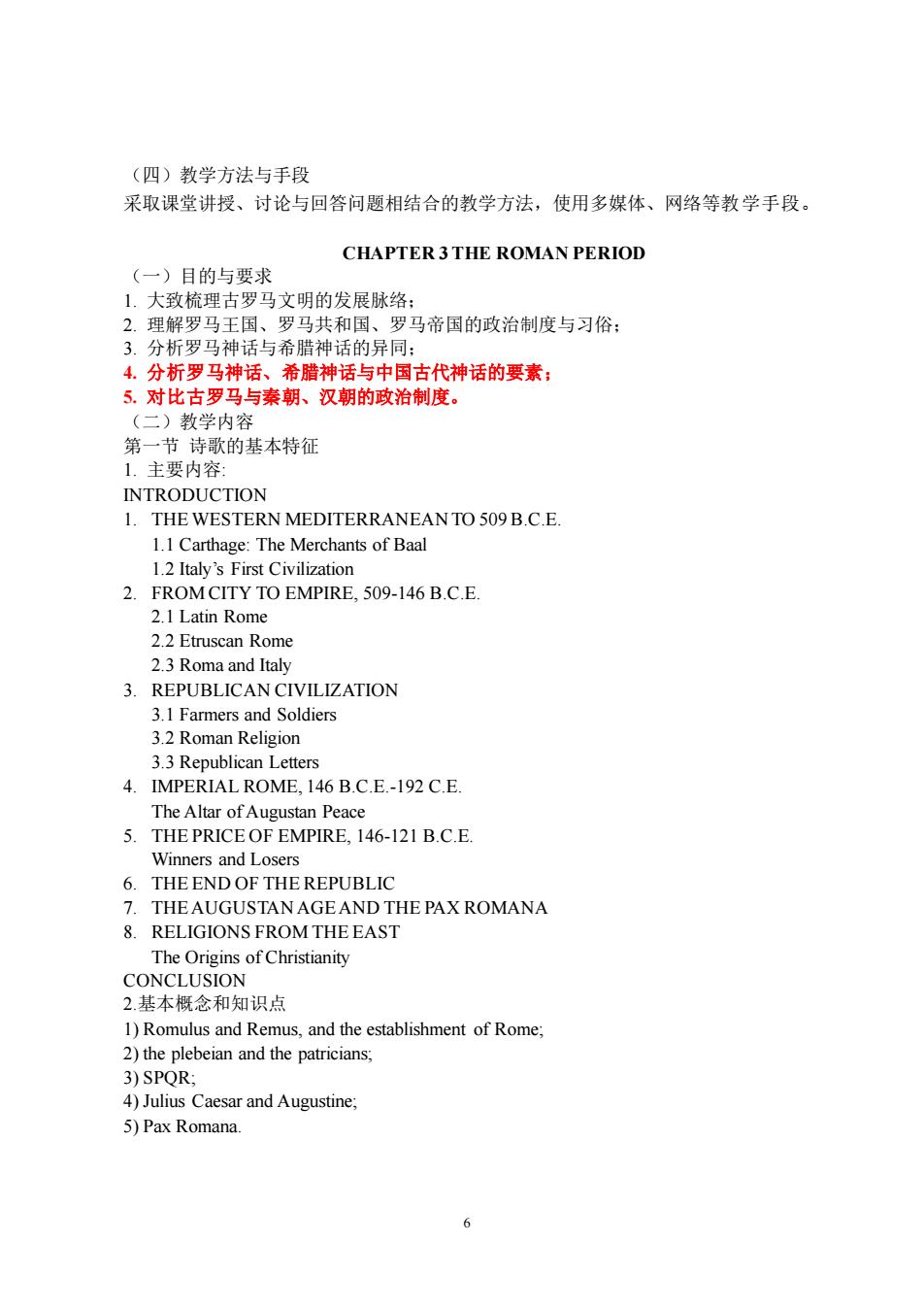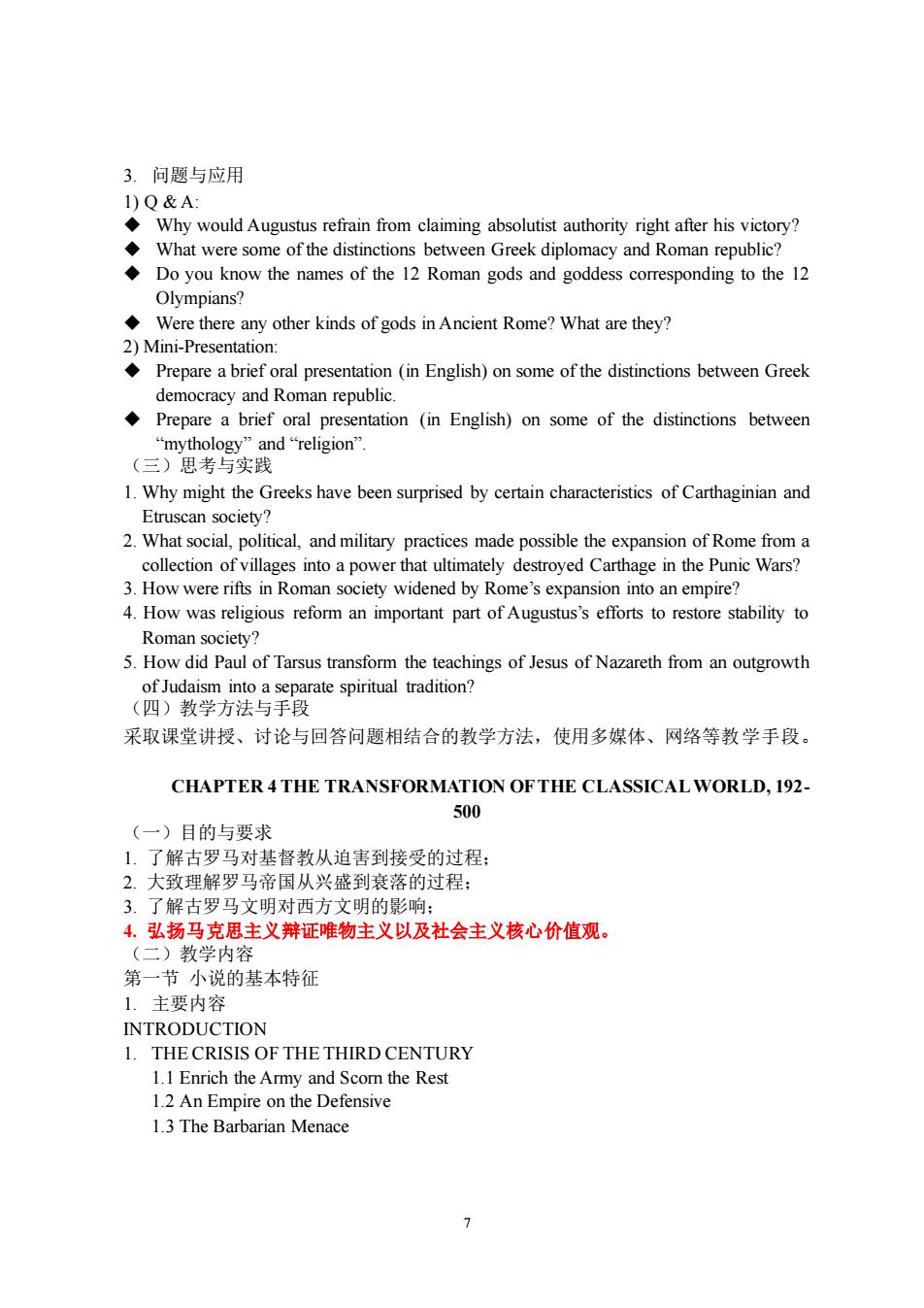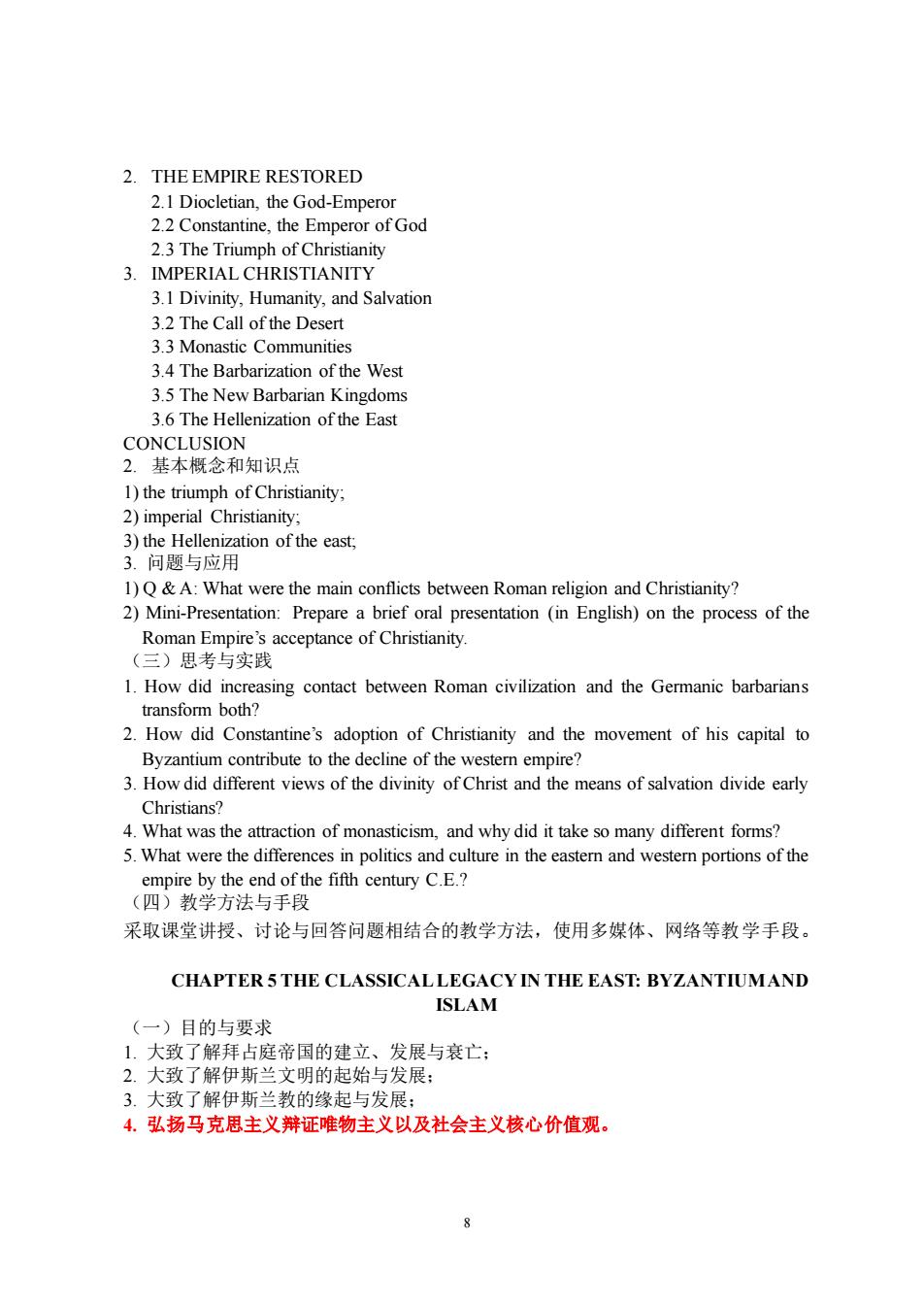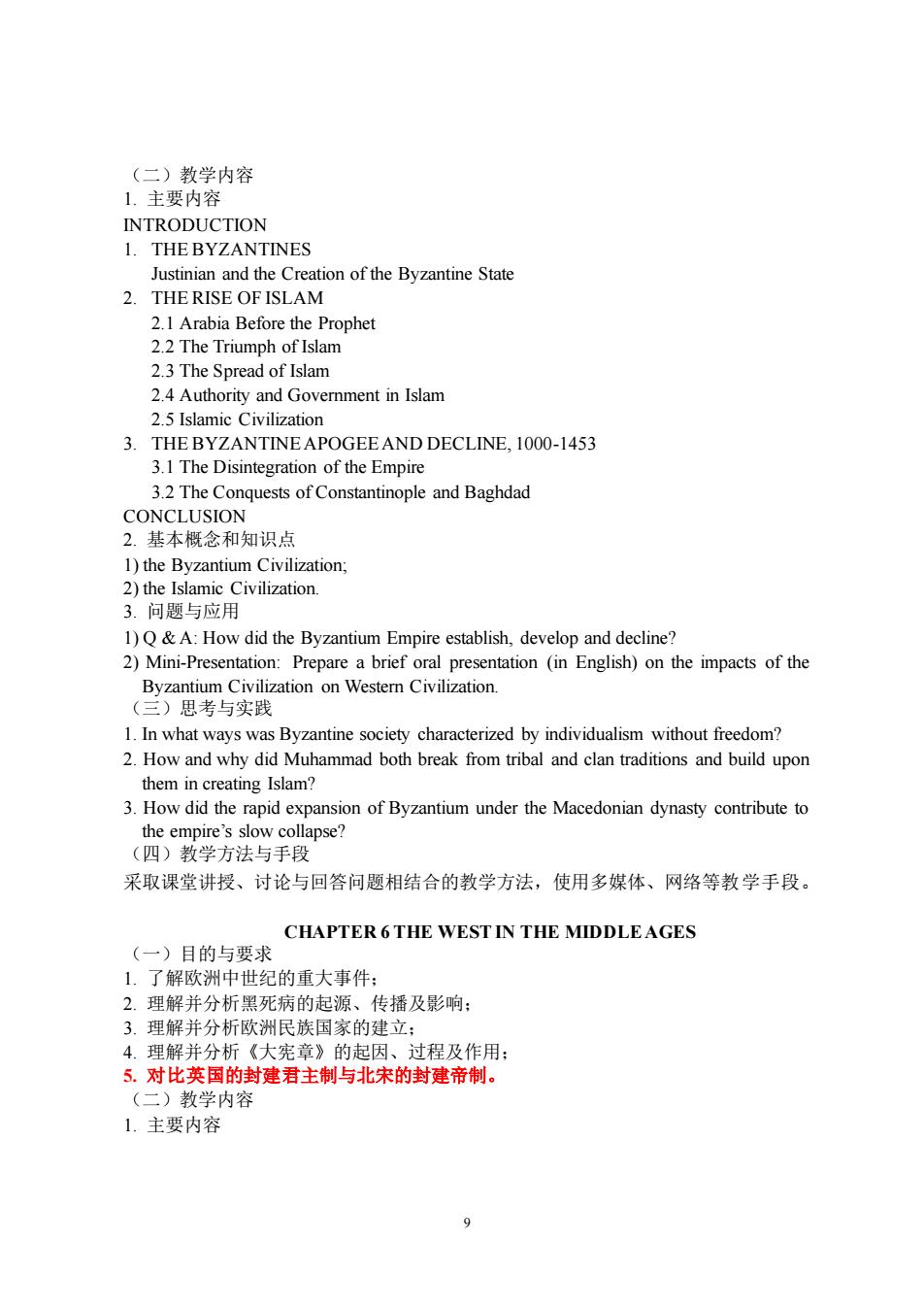
(四)教学方法与手段 采取课堂讲授、讨论与回答问题相结合的教学方法,使用多媒体、网络等教学手段。 CHAPTER 3THE ROMAN PERIOD (一)目的与要求 1.大致梳理古罗马文明的发展脉络: 2.理解罗马王国、罗马共和国、罗马帝国的政治制度与习俗: 3.分析罗马神话与希腊神话的异同: 4分析罗马神话、希腊神话与中国古代神话的要素 5.对比古罗马与秦朝、汉朝的政治制度。 (二)教学内容 第一节诗歌的基本特征 1.主要内容: INTRODUCTION THE WESTERN MEDITERRANEANTO 509 B.C.E 1.I Carthage:The Merchants of Baal 1.2 Italy's First Civilization 2 FROMCITY TO EMPIRE 509-146 BC E 2.1 Latin Ro me 22 Etruscan Rome 2.3 Roma and Italy 3.REPUBLICAN CIVILIZATION 3.1 Farmers and Soldiers 32 Roman Religion 3.3 Re epublic can Letters 4. IMPERIAL ROME,146 B.C.E.-192 C.E. The altar of augustan peace 5 THE PRICEOF EMPIRE 146-121 BCE and loser 6.THE END OF THE REPUBLIC 7.THE AUGUSTANAGEAND THE PAX ROMANA 8 RELIgions FROMTHE EAST The Origins of Christianity CONCLUSION 2基本概念和知识点 1)Romulus and Remus,and the establishment of Rome 2)the plebeian and the patricians; 3)SPQR; 4)Julius Caesar and Augustine 5)Pax Romana 6
6 (四)教学方法与手段 采取课堂讲授、讨论与回答问题相结合的教学方法,使用多媒体、网络等教学手段。 CHAPTER 3 THE ROMAN PERIOD (一)目的与要求 1. 大致梳理古罗马文明的发展脉络; 2. 理解罗马王国、罗马共和国、罗马帝国的政治制度与习俗; 3. 分析罗马神话与希腊神话的异同; 4. 分析罗马神话、希腊神话与中国古代神话的要素; 5. 对比古罗马与秦朝、汉朝的政治制度。 (二)教学内容 第一节 诗歌的基本特征 1. 主要内容: INTRODUCTION 1. THE WESTERN MEDITERRANEAN TO 509 B.C.E. 1.1 Carthage: The Merchants of Baal 1.2 Italy’s First Civilization 2. FROM CITY TO EMPIRE, 509-146 B.C.E. 2.1 Latin Rome 2.2 Etruscan Rome 2.3 Roma and Italy 3. REPUBLICAN CIVILIZATION 3.1 Farmers and Soldiers 3.2 Roman Religion 3.3 Republican Letters 4. IMPERIAL ROME, 146 B.C.E.-192 C.E. The Altar of Augustan Peace 5. THE PRICE OF EMPIRE, 146-121 B.C.E. Winners and Losers 6. THE END OF THE REPUBLIC 7. THE AUGUSTAN AGE AND THE PAX ROMANA 8. RELIGIONS FROM THE EAST The Origins of Christianity CONCLUSION 2.基本概念和知识点 1) Romulus and Remus, and the establishment of Rome; 2) the plebeian and the patricians; 3) SPQR; 4) Julius Caesar and Augustine; 5) Pax Romana

3.问题与应用 1)O&A: Why would Augustus refrain from claiming absolutist authority right after his victory? ◆What were some of the distinc etween Greek diplom cy and Roman republic Do you know the names of the 12 Roman gods and goddess corresponding to the 12 Olvmpians? Were there any other kinds of gods in Ancient Rome?What are they? 2)Mini-Presentation: ◆ repare a brief oral presentation(in English)onsome of the distinctions between Greek racy an nd Roman republic Prepare a brief oral presentation (in English)on some of the distinctions between "mythology"and "religion (三)思老与实践 1.Why might the Greeks have been surprised by certain characteristics of Carthaginian and Etruscan society? 2.What social,political,and military practices made possible the expansion of Rome from a collection of villages into a power that ultimately destroyed Carthage in the Punic Wars? 3.How were rifts in Roman society widened by Rome's expansion into an empire? 4.How was religious reform an important part of Augustus's efforts to restore stability to Roman society? 5.How did Paul of Tarsus transform the teachings of Jesus of Nazareth from an outgrowth of Judaism into a separate spiritual tradition (四)教学方法与手段 采取课堂讲授、讨论与回答问题相结合的教学方法,使用多媒体、网络等教学手段 CHAPTER 4 THE TRANSFORMATION OFTHE CLASSICAL WORLD,192- 500 (一)目的与要求 1了解古罗巴对基督教从拍害到接哥的时程 2,大致理解罗马帝国从兴盛到衰落的过程: 了解古罗马文明对西方文明的影响 4.弘扬马克思主义辩证唯物主义以及社会主义核心价值观。 (二)教学内容 第一节小说的基本特征 1.主要内容 INTRODUCTION 1.THE CRISIS OF THE THIRD CENTURY 11 Enrich the Army and Scomn the Rest 1.2 An Empire on the Defensive 1.3 The Barbarian Menace
7 3. 问题与应用 1) Q & A: ◆ Why would Augustus refrain from claiming absolutist authority right after his victory? ◆ What were some of the distinctions between Greek diplomacy and Roman republic? ◆ Do you know the names of the 12 Roman gods and goddess corresponding to the 12 Olympians? ◆ Were there any other kinds of gods in Ancient Rome? What are they? 2) Mini-Presentation: ◆ Prepare a brief oral presentation (in English) on some of the distinctions between Greek democracy and Roman republic. ◆ Prepare a brief oral presentation (in English) on some of the distinctions between “mythology” and “religion”. (三)思考与实践 1. Why might the Greeks have been surprised by certain characteristics of Carthaginian and Etruscan society? 2. What social, political, and military practices made possible the expansion of Rome from a collection of villages into a power that ultimately destroyed Carthage in the Punic Wars? 3. How were rifts in Roman society widened by Rome’s expansion into an empire? 4. How was religious reform an important part of Augustus’s efforts to restore stability to Roman society? 5. How did Paul of Tarsus transform the teachings of Jesus of Nazareth from an outgrowth of Judaism into a separate spiritual tradition? (四)教学方法与手段 采取课堂讲授、讨论与回答问题相结合的教学方法,使用多媒体、网络等教学手段。 CHAPTER 4 THE TRANSFORMATION OF THE CLASSICAL WORLD, 192- 500 (一)目的与要求 1. 了解古罗马对基督教从迫害到接受的过程; 2. 大致理解罗马帝国从兴盛到衰落的过程; 3. 了解古罗马文明对西方文明的影响; 4. 弘扬马克思主义辩证唯物主义以及社会主义核心价值观。 (二)教学内容 第一节 小说的基本特征 1. 主要内容 INTRODUCTION 1. THE CRISIS OF THE THIRD CENTURY 1.1 Enrich the Army and Scorn the Rest 1.2 An Empire on the Defensive 1.3 The Barbarian Menace

2.THE EMPIRE RESTORED 2.1 Diocletian,the God-Emperor 2.2 Constantine,the Emperor of God 2 3 The Triumnh of Ch 3.IMPERIAL CHRISTIANI 3.1 Divinity.Humanity.and Salvation 3.2 The Call of the Desert 33 Monastic Communities 3.4 The Barbarization of the Wes 3.5 The New Barbarian Ki ngdo 3.6 The Hellenization of the East CONCLUSION 2.基本概念和知识点 1)the triumph of Christianity 2) imperial Christianty 3)t ation of the east. 3.问题与应 1)Q&A:What were the main conflicts between Roman religion and Christianity? 2)Mini-Presentation:Prepare a brief oral presentation (in English)on the process of the Roman Emr (三)思考与实 acceptance of Christianity 1.How did increasing contact between Roman civilization and the Germanic barbarians transform both? 2.How did Constantine's adoption of Christianity and the movement of his capital to Byzantium contribute to the decline of the westem pire? 3.How did different views of the divinity of Christ and the means of salvation divide early Christians' 4.What was the attraction of monasticism.and why did it take so many different forms? 5.What were the differences in politics and culture in the eastern and western portions of the empire by the end of the fifth century C.e? (四)教学方法与手段 采取课堂讲授、讨论与回答问题相结合的教学方法,使用多媒体、网络等教学手段。 CHAPTER5THE CLASSICALLEGACYIN THE EAST:BYZANTIUMAND ISLAM (一)目的与要求 大致了解拜占庭帝因的建立 发展与衰亡: 2.大致了解伊斯兰文明的起始与发展: 3.大致了解伊斯兰教的缘起与发展: 4,弘扬马克思主义辩证唯物主义以及社会主义核心价值观
8 2. THE EMPIRE RESTORED 2.1 Diocletian, the God-Emperor 2.2 Constantine, the Emperor of God 2.3 The Triumph of Christianity 3. IMPERIAL CHRISTIANITY 3.1 Divinity, Humanity, and Salvation 3.2 The Call of the Desert 3.3 Monastic Communities 3.4 The Barbarization of the West 3.5 The New Barbarian Kingdoms 3.6 The Hellenization of the East CONCLUSION 2. 基本概念和知识点 1) the triumph of Christianity; 2) imperial Christianity; 3) the Hellenization of the east; 3. 问题与应用 1) Q & A: What were the main conflicts between Roman religion and Christianity? 2) Mini-Presentation: Prepare a brief oral presentation (in English) on the process of the Roman Empire’s acceptance of Christianity. (三)思考与实践 1. How did increasing contact between Roman civilization and the Germanic barbarians transform both? 2. How did Constantine’s adoption of Christianity and the movement of his capital to Byzantium contribute to the decline of the western empire? 3. How did different views of the divinity of Christ and the means of salvation divide early Christians? 4. What was the attraction of monasticism, and why did it take so many different forms? 5. What were the differences in politics and culture in the eastern and western portions of the empire by the end of the fifth century C.E.? (四)教学方法与手段 采取课堂讲授、讨论与回答问题相结合的教学方法,使用多媒体、网络等教学手段。 CHAPTER 5 THE CLASSICAL LEGACY IN THE EAST: BYZANTIUM AND ISLAM (一)目的与要求 1. 大致了解拜占庭帝国的建立、发展与衰亡; 2. 大致了解伊斯兰文明的起始与发展; 3. 大致了解伊斯兰教的缘起与发展; 4. 弘扬马克思主义辩证唯物主义以及社会主义核心价值观

(二)教学内容 1.主要内容 INTRODUCTION 1.THE BYZANTINES tinian and the Creation of the Byzantine State 2.THE RISE OF ISLAM 2.1 Arabia Before the Prophet 2.2 The Triumph of Islam 2.3 The Spread of Islan 24 Authority and Govemment in Islam 2.5 Islamic Civilization 3.THE BYZANTINEAPOGEEAND DECLINE,1000-1453 3.1 The Disintegration of the Empire 3.2The Conquests of Constantinople and Baghdad CONCLUSION 2 基本概念和知识点 1)the Byzantium Civilization; 2)the Islamic Civilization. 3问题与应用 )Q&A:How did the Byzantium Er establish,develop and decline? 2)Mini-Presentation:Prepare a brief oral presentation (in English)on the impacts of the Byzantium Civilization on Western Civilization. (三)思考与实践 1.In what ways was Byzantine society characterized by individualism without freedom? 2.How and why did Muhammad both break from tribal and clan traditions and build upon them in creating Islam? 3.How did the rapid expansion of Byzantium under the Macedonian dynasty contribute to the empire's slow collapse? (四)教学方法与手段 采取课堂讲授、讨论与回答问题相结合的教学方法,使用多媒体、网络等教学手段。 CHAPTER 6 THE WEST IN THE MIDDLEAGES (一)目的与要求 1.了解欧洲中世纪的重大事件 2.理解并分析黑死病的起源、 传播及影响 理解并分析欧洲民族国家的建立: 4.理解并分析《大宪章》的起因、过程及作用 5.对比英国的封建君主制与北宋的封建帝制。 (二)教学内容 1.主要内容
9 (二)教学内容 1. 主要内容 INTRODUCTION 1. THE BYZANTINES Justinian and the Creation of the Byzantine State 2. THE RISE OF ISLAM 2.1 Arabia Before the Prophet 2.2 The Triumph of Islam 2.3 The Spread of Islam 2.4 Authority and Government in Islam 2.5 Islamic Civilization 3. THE BYZANTINE APOGEE AND DECLINE, 1000-1453 3.1 The Disintegration of the Empire 3.2 The Conquests of Constantinople and Baghdad CONCLUSION 2. 基本概念和知识点 1) the Byzantium Civilization; 2) the Islamic Civilization. 3. 问题与应用 1) Q & A: How did the Byzantium Empire establish, develop and decline? 2) Mini-Presentation: Prepare a brief oral presentation (in English) on the impacts of the Byzantium Civilization on Western Civilization. (三)思考与实践 1. In what ways was Byzantine society characterized by individualism without freedom? 2. How and why did Muhammad both break from tribal and clan traditions and build upon them in creating Islam? 3. How did the rapid expansion of Byzantium under the Macedonian dynasty contribute to the empire’s slow collapse? (四)教学方法与手段 采取课堂讲授、讨论与回答问题相结合的教学方法,使用多媒体、网络等教学手段。 CHAPTER 6 THE WEST IN THE MIDDLE AGES (一)目的与要求 1. 了解欧洲中世纪的重大事件; 2. 理解并分析黑死病的起源、传播及影响; 3. 理解并分析欧洲民族国家的建立; 4. 理解并分析《大宪章》的起因、过程及作用; 5. 对比英国的封建君主制与北宋的封建帝制。 (二)教学内容 1. 主要内容